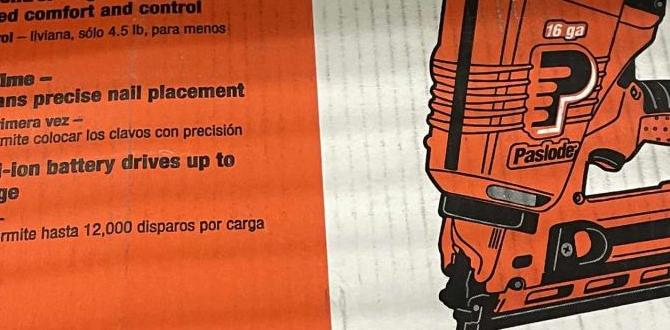Quick Summary: Regularly cleaning your battery nail gun’s vents ensures optimal performance and extends its lifespan. This guide provides a simple, step-by-step method using common household items to safely clear debris and dust from vent openings, keeping your tool running smoothly for every project.
Hey there, DIY enthusiasts and budding woodworkers! Jack Shaffer here, your go-to guy at Nailerguy for all things fastening. Ever felt that frustrating dip in power from your trusty battery nail gun? You know, the one where it just doesn’t fire with the same punch, or worse, jams up mid-project? Often, the culprit isn’t a dead battery or a faulty mechanism, but something much simpler: clogged vents.
Dust, sawdust, and general workshop grime love to sneak into these little openings. When they build up, they can restrict airflow, cause overheating, and make your nailer work harder than it needs to. This can lead to less efficient operation and even shorten the life of your tool. But don’t you worry! Cleaning these vents is a piece of cake. With just a few common items and a few minutes of your time, you can get your nail gun breathing freely again.
In this guide, I’ll walk you through exactly how to tackle those battery nail gun vents, step by step. We’ll cover the tools you’ll need, the process itself, and some handy tips to keep your nailer in top shape. Ready to bring back that powerful nail-firing action? Let’s get your tool back to its best!
Table of Contents
Why Cleaning Battery Nail Gun Vents is Crucial
Think of the vents on your battery nail gun like the air intakes on a high-performance car. They’re essential for cooling the motor and electronics, especially when you’re driving that nail gun hard on a project. When these vents get clogged with the usual suspects – sawdust, wood shavings, fine dust, or even errant bits of insulation – the tool can’t get the fresh air it needs to stay cool.
This lack of proper airflow leads to a few common problems that can really throw a wrench in your woodworking plans:
- Overheating: Just like a computer can slow down when it gets too hot, your nail gun’s motor and internal components can suffer. Overheating can lead to temporary shutdowns or, in the worst cases, permanent damage.
- Reduced Performance: When the motor is struggling due to heat and restricted airflow, you’ll notice it. Your nail gun might fire with less force, leading to under-driven nails that need a good thump with a hammer to finish the job. This is inefficient and frustrating.
- Increased Wear and Tear: Forcing a tool to work harder than it should puts extra strain on its components. This can lead to premature wear on the motor, battery contacts, and other internal parts, shortening the overall lifespan of your nail gun.
- Potential for Jams: Overheating can also affect the firing mechanism, making it more prone to jams. Clearing jams is a hassle, and preventing them is always better!
The good news is that most of these issues are preventable. A little preventative maintenance, specifically cleaning those vents, goes a long way. It’s a simple task that can save you time, money, and a whole lot of frustration on your next DIY project. We’ll get into the ‘how-to’ shortly, but understanding why it’s important is the first step to making it a habit.
What You’ll Need: Simple Tools for a Big Impact
You probably already have most of what you need in your workshop or home. There’s no need for fancy, specialized equipment to clean your battery nail gun vents. Simplicity is key, and that’s what we’re aiming for here.
Gather these common items:
- Safety Glasses: Always protect your eyes, especially when working with compressed air or dislodging dust.
- Soft Brush: A paintbrush (a clean one, ideally!), an old toothbrush, or a small detailing brush works perfectly. The bristles should be soft enough not to scratch the plastic housing.
- Canned Air or Air Compressor with Blow Gun Attachment: This is your primary tool for blowing out loose debris. If using an air compressor, make sure the pressure is set to a low, safe level (around 30-40 PSI is plenty).
- Vacuum Cleaner with Crevice Tool: For removing larger debris or vacuuming up dust after blowing.
- Microfiber Cloth: For a quick wipe-down of the exterior and to catch any dust kicked up.
- Optional: Cotton Swabs (Q-tips): For reaching into slightly trickier spots if needed, but use them gently.
That’s it! See? Nothing complicated. With these simple items, you’re ready to give your nail gun the “spa treatment” it deserves and ensure it performs at its peak.
Step-by-Step Guide: How to Clean Battery Nail Gun Vents
Alright, let’s roll up our sleeves and get this done. This process is straightforward and can be completed in under 10 minutes. Remember, safety first – always ensure your nail gun is powered OFF and the battery is removed before you start any cleaning or maintenance.
Step 1: Safety First – Power Down and Remove Battery
This is the most critical step. Before you even think about picking up a brush or an air can, make sure your nail gun is completely disengaged from its power source. If your tool has a safety switch, engage it. Then, firmly remove the battery pack. This prevents any accidental firing and ensures you can work on the tool without any surprises.
Step 2: Locate the Vents
Take a close look at your battery nail gun. You’ll find ventilation slots or grilles, typically located on the body of the tool, often near the motor housing or where the battery connects. They might be on the sides, the back, or even the top. They’re usually easy to spot as they are openings designed to allow air in and out. Sometimes, there’s a main set of vents, and occasionally smaller ones elsewhere.
Tip: Refer to your nail gun’s user manual if you’re unsure. Most manuals clearly show the location of all ports and vents.
Step 3: Initial Dust Removal with a Brush
Grab your soft brush. Gently brush away any loose dust, sawdust, or debris that is visible on the outside of the vent openings. Work in a direction that pushes the debris away from the vents, not into them. If there’s a significant amount of loose debris clinging to the surface, you can use your vacuum cleaner’s crevice tool at this stage to suck it up. This pre-cleaning step prevents larger clumps from being blown deeper into the tool.
Step 4: Blow Out Debris with Compressed Air
Now for the main event. Take your canned air or air compressor (set to low pressure, remember!). Hold the nozzle a few inches away from the vents. Direct short, powerful bursts of air into and around the vent openings. The goal here is to blow out any dust and debris that has settled inside.
Work your way around all the identified vent openings. You might need to try blowing from different angles to dislodge stubborn particles. You’ll be surprised how much gunk can come flying out!
Important Note on Canned Air: When using canned air, hold the can upright to avoid spraying propellant liquid. Tilt it only when necessary and in short bursts to prevent this. If using an air compressor, ensure the regulator restricts the output to a safe, low PSI (around 30-40 PSI is ideal). High pressure can damage internal components or blow dust into areas where it’s even harder to remove.
External Link: For more on safe use of compressed air, OSHA provides guidelines on workplace safety which can be extrapolated to tool maintenance: OSHA – Compressed Air Use.
Step 5: Vacuuming Loose Debris
After blowing, you’ll likely have a cloud of dust. Use your vacuum cleaner with the crevice tool to suck up any remaining loose particles from around the vents and the body of the nail gun. This is a good time to give the rest of the tool a quick once-over with the vacuum as well. A clean tool is a happy tool!
Step 6: Detail Work (If Needed)
If you notice any stubborn debris that the air and brush couldn’t dislodge, you can carefully use a dry cotton swab. Gently swirl the swab around the opening to pick up stuck-on dust. Be careful not to push the swab too deep or leave cotton fibers behind. Again, consult your manual if you’re unsure about accessing specific areas.
Step 7: Final Wipe-Down
Take your microfiber cloth and give the exterior of your nail gun a quick wipe. This removes any residual dust and leaves your tool looking sharp. Ensure all areas, especially around the battery contacts, are clean and dry.
Step 8: Reinsert Battery and Test
Once you’re satisfied that the vents are clear and the tool is clean and dry, reinsert the battery pack securely. Turn on your nail gun (if it has an on/off switch) and test its operation. You might notice it runs smoother and fires with more consistent power.
Congratulations! You’ve successfully cleaned your battery nail gun vents. It’s a small task with a big payoff in tool performance and longevity.
How Often Should You Clean Your Nail Gun Vents?
The frequency of cleaning your battery nail gun vents really depends on how often and in what conditions you use your tool. Here’s a general guideline:
- Heavy Use (Daily/Weekly): If you’re a professional framing contractor or a DIYer who uses your nail gun for extended periods several times a week, aim to clean the vents at the end of each workday or at least every few uses.
- Moderate Use (Monthly): For hobbyists or homeowners who use their nail gun for various projects throughout the month, a quick vent clean once a month is usually sufficient. Check them before and after a larger project.
- Light/Occasional Use (Every Few Projects): If you only pull out your nail gun for very small jobs a few times a year, give the vents a clean before starting a project and again after you’ve finished. This ensures it’s ready to go and doesn’t suffer from sitting with dust buildup.
A good rule of thumb: Visually inspect the vents before and after a job. If you see dust and debris building up, it’s time to clean them, regardless of your schedule.
Troubleshooting Common Issues Related to Vents
Sometimes, even after cleaning, you might encounter issues. Here’s how vent-related problems can manifest and what to do:
Issue: Nail Gun Stops Working Mid-Project
- Likely Cause: Overheating due to blocked vents. The tool’s thermal protection has kicked in.
- Solution: Remove the battery, let the tool cool down for 15-30 minutes in a well-ventilated area. While it cools, perform a thorough vent cleaning as described above. Once cool, reinsert the battery and test briefly. If it stops again quickly, there might be a more serious internal issue.
Issue: Nails Not Driving Fully or Consistently
- Likely Cause: Motor is struggling due to restricted airflow, leading to reduced power output.
- Solution: Clean the vents thoroughly. Ensure the battery is fully charged, as a low battery can also cause this. If the problem persists after cleaning and with a full battery, check for nail job issues (e.g., firing depth setting, air pressure if it’s an air/lithium hybrid). If it’s purely a power deficit, an internal motor issue might be at play beyond simple vent cleaning.
Issue: Unusual Noises from the Tool
- Likely Cause: Debris lodged near the fan or motor, affecting its rotation, or potential overheating affecting bearing performance.
- Solution: Power down, remove battery. Attempt gentle vent cleaning with brushes and low-pressure air. Sometimes, a small piece of debris can get deeper than expected. If the noise is significant or grinding-related, it might indicate a mechanical problem that requires professional attention.
Remember all battery nail guns are a bit different, so consulting your specific model’s manual can often provide tailored troubleshooting advice.
Benefits of Maintaining Your Battery Nail Gun’s Vents
Keeping those vents clean isn’t just about fixing problems; it’s about gaining advantages. Here’s the payoff:
Performance Boost: A cool motor and clear airflow mean your nail gun will consistently deliver its maximum power. This translates to clean, consistent nail drives every time.
Extended Tool Life: Preventing overheating and motor strain is one of the best ways to ensure your expensive tool lasts for years to come. Less stress on components means less wear and tear.
Reduced Downtime: Fewer jams, fewer overheating shutdowns, and fewer under-driven nails mean you spend more time working and less time troubleshooting. Your projects will flow more smoothly.
Cost Savings: Longer tool life means you won’t need to replace your nail gun as often. Plus, avoiding overheating can prevent costly repairs.
Safer Operation: A tool that’s running optimally is generally safer to operate. Overheating can sometimes lead to unpredictable behavior, which a clean tool mitigates.
It’s always worth the minimal effort to reap these significant benefits.
Pro Tips for Vent Maintenance
Here at Nailerguy, we love making things easy and effective. Here are a few extra tips to make your vent cleaning routine even smoother:
- Clean When Cool: Always let your nail gun cool down completely before cleaning, especially if it feels warm to the touch.
- Work Over a Bin or Tarp: Doing this maintenance outdoors or over a trash can/tarp will make cleanup of all the blown-out dust a breeze.
- Regular Battery Contact Cleaning: While you’re at it, use a clean microfiber cloth and a tiny bit of denatured alcohol (ensure it’s fully evaporated before reinserting battery) to clean the battery contacts. Dirty contacts can also cause power issues.
- Storage Matters: Store your nail gun in a clean, dry place. If possible, a tool bag or case can help keep dust away from the vents when the tool is not in use.
- Listen to Your Tool: Pay attention to any changes in sound or performance. These can be early indicators that your vents (or another part) might need attention.
Incorporating these simple practices can further enhance the longevity and performance of your battery nail gun.
Frequently Asked Questions (FAQ) about Cleaning Battery Nail Gun Vents
Q1: Can I use a regular vacuum cleaner hose to clean the vents?
A1: Yes, the crevice tool attachment on a vacuum cleaner is great for sucking up loose debris from around and within the vents. Just make sure the tool is powered off and the battery is removed first.
Q2: Is it okay to use water or cleaning solutions on the vents?
A2: No. It’s best to keep liquids away from your nail gun’s internal components. Use only dry methods like brushing and compressed air to clean the vents. Moisture can damage electronics and cause corrosion.
Q3: My nail gun feels very hot after use, even after cleaning the vents. What could be wrong?
A3: If the tool is still overheating after thorough vent cleaning, the motor might be working too hard due to excessive wear, or there could be an issue with the cooling fan itself. Overuse without breaks can also contribute. Allow it to cool down completely. If the issue persists, it might be time to consult the manufacturer or a qualified repair technician.
Q4: How can I prevent dust from getting into the vents in the first place?
A4: Proper storage is key. Keep your nail gun in a clean case or bag when not in use. You can also perform a quick brush and air dust-off after each major project. Working in cleaner conditions, if possible (using dust collection systems or sweeping up debris as you go), also helps.
Q5: Should I be worried about blowing too hard with compressed air?
A5: Yes, you should be cautious. Using excessively high air pressure (over 40-50 PSI) can potentially damage delicate internal components or send debris deeper into the tool where it’s harder to remove. Always use low pressure and short bursts.
Q6: Are battery nail gun vents the same as pneumatic nailer vents?
A6: While both types of nailers require airflow for cooling, battery-powered nailers have internal electric motors and electronics that generate heat and need ventilation. Pneumatic nailers operate on compressed air and might have fewer or different types of vents, but basic principles of keeping them free of debris apply to ensure efficient operation



